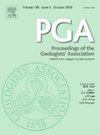The Culham Brickworks, Oxfordshire, England: New insights from 1852 on a puzzling Jurassic–Cretaceous section
IF 1.3
4区 地球科学
Q2 Earth and Planetary Sciences
引用次数: 0
Abstract
The Culham Brickworks was active from before 1850 for about 100 years and during its existence provided the only good exposure of the Early Cretaceous sub-Gault Formation unconformity in the Oxfordshire area of England. Six descriptions date from 1852 to 1926 detailing different sections as they were exposed in the ca. 350 m length of the excavations which moved gradually eastwards along the Thames riverbank. Over most of the excavated length the Gault Formation lies unconformably on the Late Jurassic Kimmeridge Clay Formation, but to the west the Aptian Lower Greensand Group intervenes and thickens to at least 4 m. A section described by John Phillips in 1860 has proved controversial, particularly for the claimed presence of 9 ft (2.7 m) of Kimmeridge Clay sands that were not seen by others. The earliest description is an unpublished manuscript from ca. 1852 by Daniel Sharpe containing previously unmentioned information, including a cross-section. This defines the Lower Greensand geometry more precisely and also throws additional doubt on Phillips' description. Using Sharpe's sections rather than Phillips', a cross-section has been drawn covering the entire length of the excavations. This illustrates significant relief at both the top of the Kimmeridge Clay Formation and the base of the Gault Formation. This reconstruction provides an essential starting point for any wider study of the Lower Greensand sandbody geometry and the nature of the sub-Gault Formation unconformity. The zonation of the Gault at the Brickworks continues to be reinterpreted, but the results are ambiguous.
英国牛津郡的Culham砖厂:1852年对令人费解的侏罗纪-白垩纪剖面的新见解
Culham Brickworks从1850年以前开始活跃了大约100 年,在其存在期间为英国牛津郡地区早白垩世次高尔特组不整合提供了唯一的良好暴露。从1852年到1926年的六个描述详细描述了不同的部分,因为它们暴露在大约350 米长的挖掘中,沿着泰晤士河岸边逐渐向东移动。在大部分挖掘长度上,高尔特组不整合位于晚侏罗世Kimmeridge粘土组上,但在西部,阿普田下格林山群介入并增厚至至少4 m。John Phillips在1860年描述的部分被证明是有争议的,特别是声称存在9 英尺(2.7 米)的Kimmeridge粘土砂,而其他人没有看到。最早的描述是丹尼尔·夏普(Daniel Sharpe)约1852年未发表的手稿,其中包含以前未提及的信息,包括横截面。这更精确地定义了下格林桑的几何形状,也给菲利普斯的描述带来了额外的怀疑。使用夏普的剖面而不是菲利普斯的剖面,绘制了覆盖整个挖掘长度的横截面。这说明了在Kimmeridge粘土组的顶部和高尔特组的底部都有显著的浮雕。这种重建为更广泛地研究下格林沙洲砂体几何形状和亚高尔特组不整合的性质提供了一个重要的起点。砖厂高台的分区继续被重新解释,但结果是模棱两可的。
本文章由计算机程序翻译,如有差异,请以英文原文为准。
求助全文
约1分钟内获得全文
求助全文
来源期刊
CiteScore
2.70
自引率
8.30%
发文量
54
审稿时长
6-12 weeks
期刊介绍:
The Proceedings of the Geologists'' Association is an international geoscience journal that was founded in 1859 and publishes research and review papers on all aspects of Earth Science. In particular, papers will focus on the geology of northwestern Europe and the Mediterranean, including both the onshore and offshore record. Following a long tradition, the PGA will focus on: i) a range of article types (see below) on topics of wide relevance to Earth Sciences ii) papers on aspects of Earth Science that have societal relevance including geoconservation and Earth management, iii) papers on palaeoenvironments and palaeontology of the Mesozoic and Cenozoic, iv) papers on aspects of Quaternary geology and climate change, and v) papers on the history of geology with particular reference to individuals that have shaped the subject. These topics will also steer the content of the themes of the Special Issues that are published in the PGA.

 求助内容:
求助内容: 应助结果提醒方式:
应助结果提醒方式:


